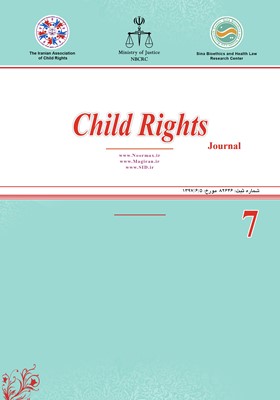The Measures of Reacting to Pedophiles in Offenses against Children; Punishment or Treatment?
Subject Areas : child rightsamir samavati pirouz 1 , hassan bigdeli 2
1 - Associate Professor, Department of Law and Political Science, Karaj Branch, Islamic Azad University, Karaj, Iran
2 - A in Criminal law and Criminology, Faculty of Law and Political Science, Karaj Branch, Islamic Azad University, Karaj, Iran
Keywords: Pedophiles, Children, Sexual offenders, Punishments,
Abstract :
Pedophilia is one of the paraphilic mental disorders and is one of the groups of child abuse in heterosexual, homosexual and bisexual pedophiles. This disease is caused by a person's emotions and imagination. One of the best ways to identify pedophiles is to examine the person's instinctive reactions to audio and video stimuli related to children. The results of this research, based on descriptive-analytical method and using library tools, include that there is no definite and acceptable treatment for this disease, and that the measures proposed by experts include drug treatment and creating impotence. These measures are very effective in preventing crime because a pedophile, like other criminals, initially investigates the cost of the crime, and if he closes the government sponsors the act and can hide behind the mask of a patient, commits the crime. However, high penalties can be a serious deterrent to crime prevention. In Iran, according to recent cases and in accordance with Islamic jurisprudence, the perpetrators of these crimes, along with having elements constituting a crime, have considered class punishments in such a way that the legislator in articles of the law criminalizes acts against children and It has considered the punishment of imprisonment and flogging, and in other articles, it has considered a heavier punishment in case of sexual offenses such as intercrural sex and tribadism, and a much higher punishment in case of adultery and sodomy.
1. Medaris M, Girouard C. Protecting children in cyberspace: The ICAC task force program. US Department of Justice, Office of Justice Programs, Office of Juvenile Justice and Delinquency Prevention; 2002.
2. Winslade W, Stone TH, Smith-Bell M, Webb DM. Castrating pedophiles convicted of sex offenses against children: new treatment or old punishment. SMUL Rev. 1997; 51: 349.
3. Smallbone SW, Wortley RK. Criminal diversity and paraphilic interests among adult males convicted of sexual offenses against children. International Journal of Offender Therapy and Comparative Criminology. 2004; 48(2): 175-88.
4. Taber CW. Taber's Cyclopedic Medical Dictionary. Philadelphia, USA: FA Davis Company; 1963.
5. Attari A, Amin al-Ruaya M. A Review of DSM-5, Behavioral Sciences Research 2013; 11(2): 148.
6. Groth AN, Burgess AW. Sexual trauma in the life histories of rapists and child molesters. International Journal of Victimology 1979; 4(1): 10-6.
7. American Psychiatric Association. Diagnostic and Statistical Manual of Mental Disorders. Revised 4th ed. Washington DC: American Psychiatric Pub.; 2000.
8. Ouhadi B. Human Sexual Tendencies and Behaviors. Tehran: Sadegh Hedayat Publications, 2000; p. 217.
9. Hall RC, Hall RC. A profile of pedophilia: definition, characteristics of offenders, recidivism, treatment outcomes, and forensic issues. In Mayo Clinic Proceedings 2007 Apr 1 (Vol. 82, No. 4, pp. 457-471). Elsevier.
10. Letourneau EJ. A comparison of objective measures of sexual arousal and interest: Visual reaction time and penile plethysmography. Sexual Abuse: A Journal of Research and Treatment 2002; 14(3): 203-19.
11. Sermabeikian P, Martinez D. Treatment of adolescent sexual offenders: Theory-based practice. Child Abuse & Neglect 1994; 18(11): 969-76.
12. Sartorius A, Ruf M, Kief C, Demirakca T, Bailer J, Ende G, et al. Abnormal amygdala activation profile in pedophilia. European Archives of Psychiatry and Clinical Neuroscience 2008; 258(5): 271-7.
13. Valipour SH. Pedophilia from a legal perspective. 2017. Available at: http://magazine.shme.ir/1395/12/22/%D9%BE%D8%AF%D9%88%D9%81%D9%8A%D9%84%DB%8C%D8%A7%D8%B2%D9%85%D9%86%D8%B8%D8%B1%D8%AD%D9%82%D9%88%D9%82%DB%8C/.
14. Hall RC, Hall RC. A profile of pedophilia: definition, characteristics of offenders, recidivism, treatment outcomes, and forensic issues. InMayo Clinic Proceedings 2007 Apr 1 (Vol. 82, No. 4, pp. 457-471). Elsevier.
15. Egan V, Kavanagh B, Blair M. Sexual offenders against children: The influence of personality and obsessionality on cognitive distortions. Sexual Abuse: A Journal of Research and Treatment 2005; 17(3): 223-40.
16. Bloom JD, Bradford JM, Kofoed L. An overview of psychiatric treatment approaches to three offender groups. Psychiatric Services 1988; 39(2): 151-8.
17. Sartorius A, Ruf M, Kief C, Demirakca T, Bailer J, Ende G, et al. Abnormal amygdala activation profile in pedophilia. European Archives of Psychiatry and Clinical Neuroscience 2008; 258(5): 271-7.
18. Abel GG. The Abel and Harlow child molestation prevention study. Philadelphia, Xlibris. 2001. Available at: www.childmolestationprevention.org/pdfs /study.pdf. Accessed February 19, 2007. P 459.
19. Murray JB. Psychological profile of pedophiles and child molesters. The Journal of Psychology 2000; 134(2): 211-24.
20. Greenfeld LA. Sex offenses and offenders: An analysis of data on rape and sexual assault. US Department of Justice, Office of Justice Programs; 1997.
21. Toobert S, Bartelme KF, Jones ES. Some factors related to pedophilia. International Journal of Social Psychiatry 1959; 4(4): 272-9.
22. Butterfield F. '95 Data Show Sharp Drop in Reported Rapes. The New York Times. 1997 Feb; 3., at A14.
23. Shoaa Kazemi MA. Child Abuse and Its Consequences, Knowledge Journal 2005; 13(87): 1.
24. Stone TH, Winslade WJ, Klugman CM. Sex offenders, sentencing laws and pharmaceutical treatment: a prescription for failure. Behavioral sciences & the law 2000; 18(1): 83-110.
25. Briere J, Runtz M. University males' sexual interest in children: Predicting potential indices of “pedophilia” in a nonforensic sample. Child Abuse & Neglect 1989;13(1): 65-75.


